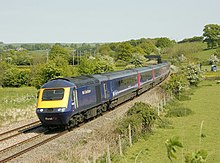Berks and Hants Line
| Reading–Taunton line | |
|---|---|

A Great Western HST approaching Great Cheverell on its way to Westbury.
|
|
| Overview | |
| Type | Heavy rail |
| System | National Rail |
| Status | Operational |
| Locale |
South East England South West England |
| Termini |
Reading Taunton |
| Operation | |
| Opened | 1906 |
| Owner | Network Rail |
| Operator(s) | Great Western Railway |
| Technical | |
| Number of tracks | 2 |
| Track gauge | 1,435 mm (4 ft 8 1⁄2 in) standard gauge |
The Reading–Taunton line is a major branch of the Great Western Main Line from which it diverges at Reading railway station. It runs to Cogload Junction (east of Taunton) where it joins the Bristol to Exeter and Penzance line.
Since 1906 it has served as the principal route from London to Devon and Cornwall, having been created by the Great Western Railway joining up several earlier railway lines. These included the Berks and Hants Railway from Reading to Hungerford and part of the Wilts, Somerset and Weymouth Railway from Westbury to Castle Cary. The whole route is sometimes confusingly called the "Berks and Hants Line".
The line became a through route on 2 July 1906 with the completion of the Langport and Castle Cary Railway. Before this, from 5 May 1848, through trains from London to Plymouth had run via Bristol: a longer route, often called the "Great Way Round" leaving only a few train services commencing east of Bristol running to Exeter via Bristol.
The various sections of line were opened:
The Reading to Hungerford section was promoted as the Berks and Hants Railway; from there to Patney & Chirton by the Berks and Hants Extension Railway; and from Westbury to Castle Cary by the Wilts, Somerset and Weymouth Railway. The section from Cogload Junction to Exeter was built by the Bristol and Exeter Railway, whose Yeovil branch became part of the new main line between Curry Rivel Junction and Athelney Junction, and including Athelney station. The section between Exeter and Plymouth was built by the South Devon Railway Company.
...
Wikipedia
